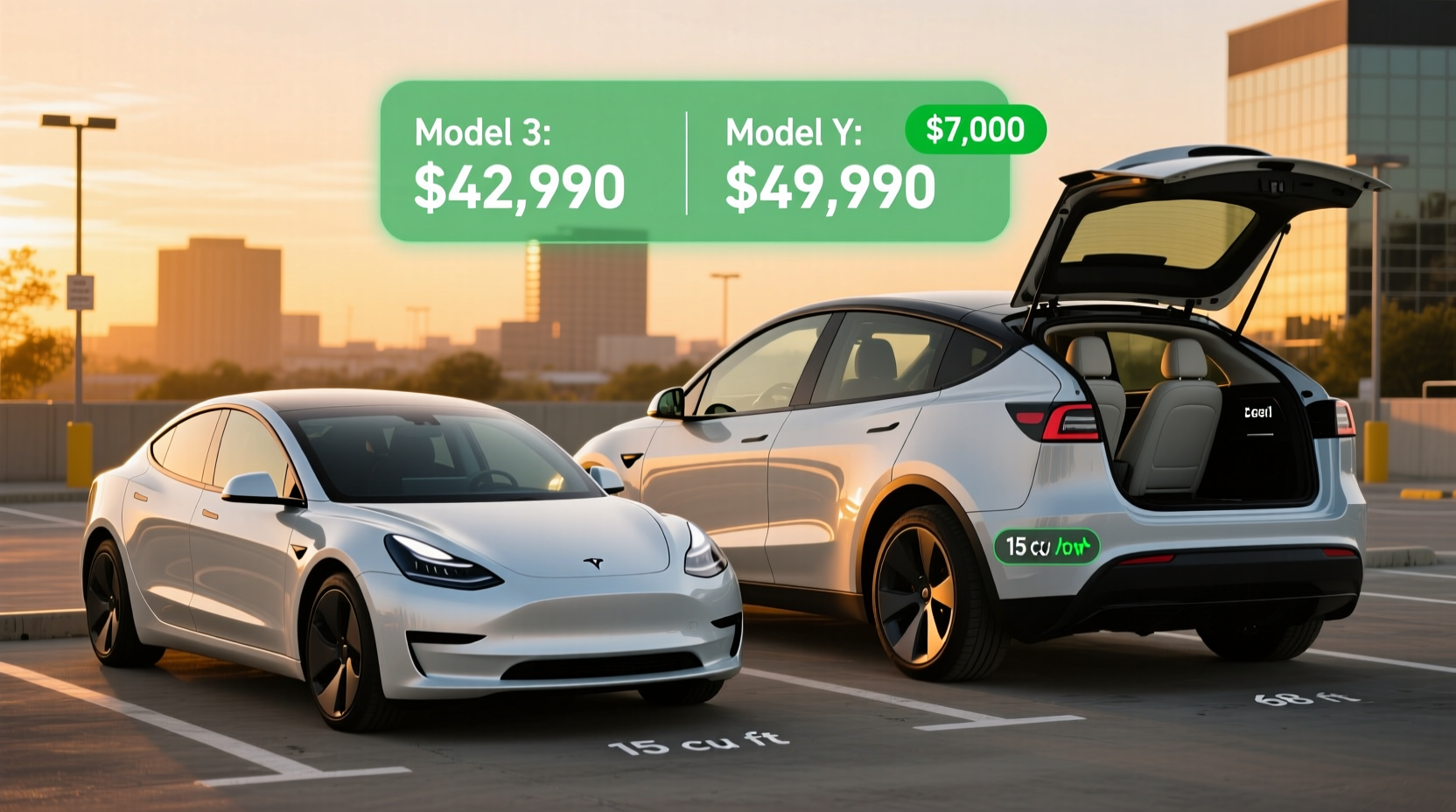When shopping for a Tesla, two of the most popular choices are the Model 3 and the Model Y. Both vehicles share much of the same technology, powertrain, and design language, but they serve slightly different lifestyles. The Model 3 is a sleek, sporty sedan; the Model Y is a compact SUV built on the same platform but with added height, cargo space, and seating capacity. For many buyers, the central question becomes: Is the extra space and versatility of the Model Y worth the additional cost over the more affordable Model 3?
This decision isn’t just about dimensions or price tags—it’s about how each car fits into your daily life. Whether you're a solo commuter, a parent, or someone who regularly hauls gear, the answer depends on usage patterns, budget constraints, and long-term value expectations.
Design and Dimensions: Sedan vs Compact SUV

The Model 3 and Model Y are often mistaken for one another at first glance. They share nearly identical front fascias, interior layouts, and even production lines. However, their structural differences define their character.
The Model 3 is a midsize electric sedan designed for aerodynamic efficiency and driving dynamics. It sits lower to the ground, offering a sportier profile and improved handling due to its lower center of gravity. In contrast, the Model Y is a crossover SUV that stands taller, rides higher, and provides a more commanding view of the road. Despite sharing up to 75% of components, the Y's roofline is raised, and the rear overhang is extended—giving it more interior volume.
Key dimensional differences include:
| Feature | Tesla Model 3 | Tesla Model Y |
|---|---|---|
| Length | 184.8 inches | 187.0 inches |
| Height | 56.8 inches | 63.9 inches |
| Wheelbase | 113.2 inches | 113.8 inches |
| Ground Clearance | 5.4 inches | 6.6 inches |
| Seating Capacity | 5 | 5 (optional 7-seat configuration) |
| Cargo Volume (rear seats up) | 15 cu ft | 28 cu ft |
| Cargo Volume (rear seats folded) | 23 cu ft | 68 cu ft |
| Front Trunk (Frunk) | 3.1 cu ft | 3.6 cu ft |
The most striking difference is cargo capacity. The Model Y nearly doubles usable space behind the rear seats and offers almost triple the total when folding them down. This makes a tangible difference for families, outdoor enthusiasts, or anyone who frequently transports bulky items.
Pricing and Value Proposition
As of 2024, the base rear-wheel-drive versions start at approximately $38,990 for the Model 3 and $43,990 for the Model Y—a $5,000 difference. While both qualify for federal EV tax credits under certain conditions, the gap remains meaningful for budget-conscious buyers.
However, value isn’t solely determined by sticker price. Resale value, insurance premiums, maintenance costs, and utility must be factored in. According to data from Kelley Blue Book and iSeeCars, both models retain strong resale values, but the Model Y tends to depreciate slightly slower due to higher demand in the SUV segment.
“SUVs continue to dominate consumer preference in North America. The Model Y benefits from this trend, maintaining stronger residual values than comparably priced sedans.” — Jessica Caldwell, Executive Director of Insights at Edmunds
Moreover, the Model Y’s optional seven-seat configuration (though tight in the second row) opens it up to family use cases where the Model 3 simply can’t compete. For households with children or frequent carpooling needs, those two extra seats—even if best suited for smaller passengers—can justify the premium.
Driving Experience and Performance
On the road, both cars deliver the instant torque and quiet operation expected from Tesla’s electric drivetrains. However, the driving feel diverges due to their form factors.
The Model 3 excels in agility. Its low ride height and balanced weight distribution make it more responsive through corners. Drivers who prioritize a connected, engaging experience often favor the Model 3, especially in Performance trims that achieve 0–60 mph in under 3.1 seconds.
The Model Y, while based on the same platform, feels more like a traditional SUV. It has a slightly softer suspension tune and more body roll during aggressive maneuvers. Acceleration is still quick—especially in Long Range or Performance variants—but the added weight (around 400 lbs heavier than the Model 3) dulls some of the sharpness.
Ride comfort, however, leans in favor of the Model Y. The higher seating position reduces fatigue on long drives, and the elevated vantage point improves visibility in traffic. Additionally, the increased ground clearance allows for easier navigation over speed bumps, curbs, or light off-pavement terrain like gravel driveways.
Real-World Example: Commuter vs Family Use
Consider Sarah, a software engineer living in Seattle. She drives 45 minutes each way to work and occasionally takes weekend trips to the mountains with her dog and hiking gear. Initially drawn to the Model 3’s sleek design, she test-drove both vehicles. When loading her large dog crate, backpack, and ski boots into the trunk, the Model 3 required folding the rear seat—an inconvenience for solo trips. The Model Y swallowed the same load with rear seats upright.
She ultimately chose the Model Y despite the higher monthly payment. “I realized I wasn’t just buying a car for commuting,” she said. “I was investing in flexibility. The extra $70 a month is cheaper than renting a cargo van twice a month.”
Interior Space and Practicality
Inside, both vehicles feature minimalist cabins dominated by a 15-inch touchscreen, minimal physical buttons, and high-quality materials. But spatial perception differs significantly.
- Headroom: The Model Y offers 40.8 inches in the front and 39.6 in the rear, compared to 39.6 and 38.0 in the Model 3. That extra inch makes a noticeable difference for taller passengers.
- Legroom: Nearly identical, with both offering around 42 inches in the front and 35+ in the back.
- Shoulder Room: Slightly wider in the Model Y, particularly in the rear, thanks to its broader stance.
The panoramic glass roof extends across both models, but in the Model Y, it enhances the sense of openness. Combined with higher window lines, it creates a more airy atmosphere—especially beneficial for rear passengers prone to feeling claustrophobic in lower-slung sedans.
Storage solutions are comparable, with under-console bins, door pockets, and a center console deep enough for laptops or handbags. However, the Model Y adds a second frunk-like storage compartment beneath the rear cargo floor—a small but useful advantage for organizing tools, charging cables, or spare shoes.
Checklist: Choosing Between Model 3 and Model Y
Ask yourself these questions before deciding:
- Do I regularly transport bulky items (strollers, luggage, sports gear)? → Model Y
- Is passenger comfort for adults in the back seat a priority? → Model Y
- Do I prefer a sportier, more engaging drive? → Model 3
- Am I on a tight budget and minimizing monthly payments? → Model 3
- Do I need all-wheel drive for snow or rough roads? → Both available, but Y’s clearance helps
- Will I ever need to seat more than five people? → Model Y (7-seat option)
- Do I park in tight urban spaces or garages with low clearances? → Model 3 may fit better
Charging, Range, and Efficiency
Battery options overlap significantly. The rear-wheel-drive Model 3 offers up to 272 miles of range, while the equivalent Model Y achieves 260 miles. The Long Range AWD versions provide 341 miles (Model 3) and 330 miles (Model Y). These differences are marginal in daily use.
Efficiency favors the Model 3 due to its lower drag coefficient (Cd of 0.23 vs. 0.23–0.24 for the Y). Over time, this means slightly lower electricity costs per mile and marginally faster charging in certain conditions. However, the real-world impact is minimal—most drivers won’t notice a difference unless undertaking frequent cross-country trips.
Both support Tesla’s Supercharger network at full capability, reaching 170–200 miles of range in 15 minutes under optimal conditions. Cabin preconditioning and battery thermal management systems are identical, ensuring consistent charging speeds in cold weather.
Frequently Asked Questions
Is the Model Y just a lifted Model 3?
In essence, yes—but with meaningful upgrades. While they share platforms, batteries, and interiors, the Model Y has a reinforced frame, additional sound insulation, and revised suspension tuning to handle its increased weight and height. It’s more than just a raised version; it’s optimized for different use cases.
Can the Model 3 fit child seats comfortably?
Absolutely. The Model 3 rear seats accommodate two child seats easily. However, installing a third in the middle can be tight due to the floor hump and narrow center position. The Model Y offers more flexibility here, especially with its flatter floor and wider cabin.
Does the Model Y feel less efficient because it’s larger?
It’s slightly less efficient—about 2–4 mpg-e (miles per gallon equivalent) lower in EPA ratings—but real-world consumption varies more by driving style than vehicle size. Aggressive acceleration impacts efficiency more than the SUV form factor.
Making the Decision: Who Should Choose Which?
The choice between Model 3 and Model Y ultimately comes down to lifestyle alignment.
The **Model 3** is ideal for:
- Solo drivers or couples without children
- Enthusiasts who enjoy spirited driving
- Buyers prioritizing affordability and efficiency
- Urban dwellers with limited parking space
The **Model Y** suits those who value:
- Increased cargo and passenger flexibility
- Higher seating position and improved visibility
- Family readiness or active lifestyles
- Long-term versatility and stronger resale trends
If you’re upgrading from a gasoline-powered SUV or minivan, the Model Y feels like a natural evolution. If you’re coming from a compact sedan or coupe, the Model 3 maintains that familiar intimacy while electrifying the experience.
Final Verdict: Is the Extra Space Worth the Cost?
For many, yes—the extra space in the Model Y is absolutely worth the $5,000 premium. That investment buys tangible improvements in daily usability, adaptability, and long-term satisfaction. The ability to carry more, seat more, and store more without resorting to external solutions translates into convenience that compounds over time.
However, if your needs are simple—daily commuting, light errands, and occasional road trips—the Model 3 delivers 90% of the functionality at a lower price point. Its sharper dynamics and slightly better efficiency may appeal more to purists.
Ultimately, the Model Y isn’t just about space—it’s about freedom. Freedom from logistical hassles, from making compromises, from wondering whether your car can handle what life throws at it. For families, adventurers, and practical thinkers, that freedom has a measurable value—one that often exceeds the invoice difference.
“The Model Y represents the sweet spot in Tesla’s lineup: maximum utility with minimal sacrifice.” — Sandy Munro, Automotive Engineer and Industry Analyst









 浙公网安备
33010002000092号
浙公网安备
33010002000092号 浙B2-20120091-4
浙B2-20120091-4
Comments
No comments yet. Why don't you start the discussion?